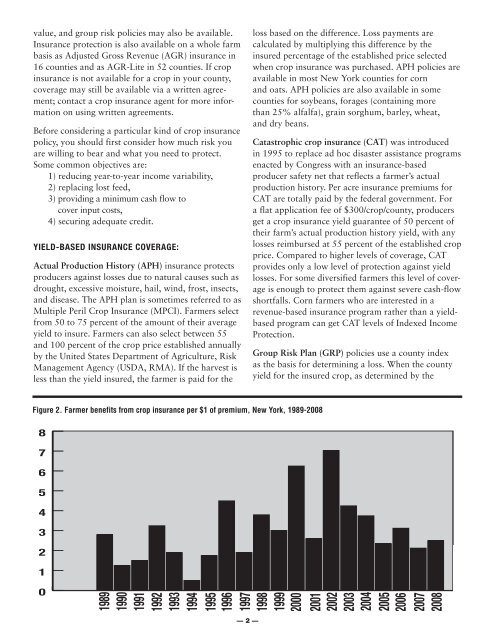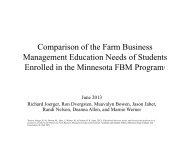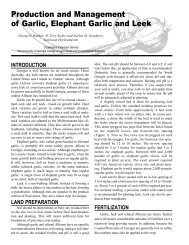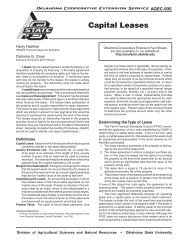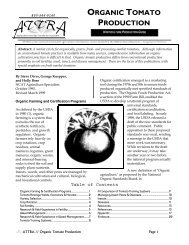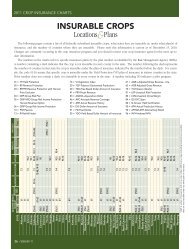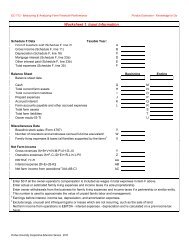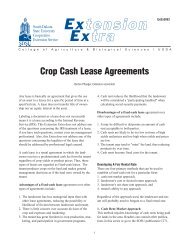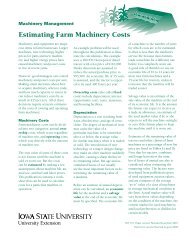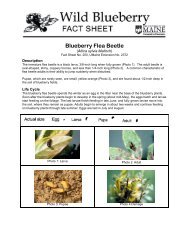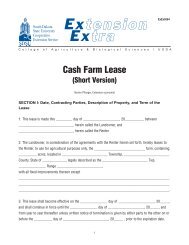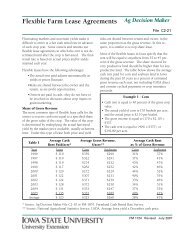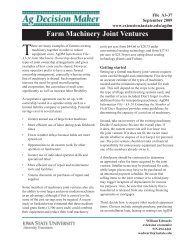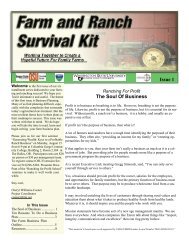Crop Insurance - National Ag Risk Education Library
Crop Insurance - National Ag Risk Education Library
Crop Insurance - National Ag Risk Education Library
You also want an ePaper? Increase the reach of your titles
YUMPU automatically turns print PDFs into web optimized ePapers that Google loves.
value, and group risk policies may also be available.<br />
<strong>Insurance</strong> protection is also available on a whole farm<br />
basis as Adjusted Gross Revenue (AGR) insurance in<br />
16 counties and as AGR-Lite in 52 counties. If crop<br />
insurance is not available for a crop in your county,<br />
coverage may still be available via a written agreement;<br />
contact a crop insurance agent for more information<br />
on using written agreements.<br />
Before considering a particular kind of crop insurance<br />
policy, you should first consider how much risk you<br />
are willing to bear and what you need to protect.<br />
Some common objectives are:<br />
1) reducing year-to-year income variability,<br />
2) replacing lost feed,<br />
3) providing a minimum cash flow to<br />
cover input costs,<br />
4) securing adequate credit.<br />
YIELD-BASED INSURANCE COVERAGE:<br />
Actual Production History (APH) insurance protects<br />
producers against losses due to natural causes such as<br />
drought, excessive moisture, hail, wind, frost, insects,<br />
and disease. The APH plan is sometimes referred to as<br />
Multiple Peril <strong>Crop</strong> <strong>Insurance</strong> (MPCI). Farmers select<br />
from 50 to 75 percent of the amount of their average<br />
yield to insure. Farmers can also select between 55<br />
and 100 percent of the crop price established annually<br />
by the United States Department of <strong>Ag</strong>riculture, <strong>Risk</strong><br />
Management <strong>Ag</strong>ency (USDA, RMA). If the harvest is<br />
less than the yield insured, the farmer is paid for the<br />
loss based on the difference. Loss payments are<br />
calculated by multiplying this difference by the<br />
insured percentage of the established price selected<br />
when crop insurance was purchased. APH policies are<br />
available in most New York counties for corn<br />
and oats. APH policies are also available in some<br />
counties for soybeans, forages (containing more<br />
than 25% alfalfa), grain sorghum, barley, wheat,<br />
and dry beans.<br />
Catastrophic crop insurance (CAT) was introduced<br />
in 1995 to replace ad hoc disaster assistance programs<br />
enacted by Congress with an insurance-based<br />
producer safety net that reflects a farmer’s actual<br />
production history. Per acre insurance premiums for<br />
CAT are totally paid by the federal government. For<br />
a flat application fee of $300/crop/county, producers<br />
get a crop insurance yield guarantee of 50 percent of<br />
their farm’s actual production history yield, with any<br />
losses reimbursed at 55 percent of the established crop<br />
price. Compared to higher levels of coverage, CAT<br />
provides only a low level of protection against yield<br />
losses. For some diversified farmers this level of coverage<br />
is enough to protect them against severe cash-flow<br />
shortfalls. Corn farmers who are interested in a<br />
revenue-based insurance program rather than a yieldbased<br />
program can get CAT levels of Indexed Income<br />
Protection.<br />
Group <strong>Risk</strong> Plan (GRP) policies use a county index<br />
as the basis for determining a loss. When the county<br />
yield for the insured crop, as determined by the<br />
Figure 2. Farmer benefits from crop insurance per $1 of premium, New York, 1989-2008<br />
8<br />
7<br />
6<br />
5<br />
4<br />
3<br />
2<br />
1<br />
0<br />
1989<br />
1990<br />
1991<br />
1992<br />
1993<br />
1994<br />
1995<br />
1996<br />
1997<br />
1998<br />
1999<br />
2000<br />
2001<br />
2002<br />
2003<br />
2004<br />
2005<br />
2006<br />
2007<br />
2008<br />
— 2 —


